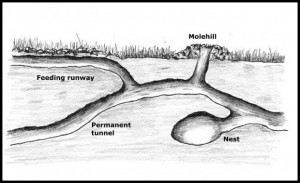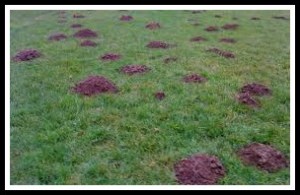Leave It Alone!
Creating a backyard ecosystem is a good thing to do for many reasons. One reason is that you, the gardener, have less work to do. Why? Because someone else does it for you. Thus, an important part of having a backyard ecosystem is leaving the parts of it alone to do the work they are there to do.
Welcome the Diggers
 Despite a somewhat shady but largely undeserved reputation, as well as their less-than-beautiful looks, moles like this one are an example of an ecosystem player that provides benefits a gardener wants.
Despite a somewhat shady but largely undeserved reputation, as well as their less-than-beautiful looks, moles like this one are an example of an ecosystem player that provides benefits a gardener wants.
So I say, welcome these little diggers to the garden!
Backyard ecosystem gardeners tend not to value pristine lawns. The mounds of dirt moles throw up in the wintertime, as they dig tunnels and forage for food, don’t seem like that big a deal. The ridges that appear in the garden the rest of the year, compliments of one or two moles, aren’t much of a problem, either. In fact, if you step on a ridge, you will notice that the dirt is soft and pliable under your feet. Its texture is loose and crumbly, just the kind of soil most gardeners want.
Hmm, is it possible the moles are doing something good down there?
According to Sara Stein, author of Noah’s Garden, the moles are indeed playing several pivotal roles in the backyard ecology. Here is just part of what she says:
“Eastern moles burrow through the soil with a breaststroke powered by musculature mightier for their size than Arnold Schwarzennegger’s … As it scoops dirt out of the way in front, the mole pushes its body forward while pressing the loosened soil upward with its back … the motion that forms the raised ridges in lawns that are a chronic nuisance to perfectionist groundskeepers … Surface tunnels are the barest indication of what lies below. They are used as temporary foraging routes for the moles’ chief food: earthworms  and beetle grubs, sometimes a slug or a snail, rarely a bite of root or bulb … Feeding tunnels are connected by vertical shafts to a deep and permanent network of horizontal tunnels some eighteen inches below. Here, moles move quickly between foraging areas, rest during the midday heat, warm up during the winter cold, and in round rooms that hold a grassy nest, rear their annual spring litter. Generation after generation uses and elaborates this deeper system, adding to both its extent and its complexity … The moles’ tireless digging — day and night, in every season of the year — churns and aerates the soil, giving anchored roots the oxygen they need, providing the storm drains of an extensive flood control network much more effective than [any measly buried pipe], and offering housing, too, for mice, voles, and shrews that would as soon profit from others’ work as do their own. Who would have guessed engineering and cosmopolitan roles for moles?”
and beetle grubs, sometimes a slug or a snail, rarely a bite of root or bulb … Feeding tunnels are connected by vertical shafts to a deep and permanent network of horizontal tunnels some eighteen inches below. Here, moles move quickly between foraging areas, rest during the midday heat, warm up during the winter cold, and in round rooms that hold a grassy nest, rear their annual spring litter. Generation after generation uses and elaborates this deeper system, adding to both its extent and its complexity … The moles’ tireless digging — day and night, in every season of the year — churns and aerates the soil, giving anchored roots the oxygen they need, providing the storm drains of an extensive flood control network much more effective than [any measly buried pipe], and offering housing, too, for mice, voles, and shrews that would as soon profit from others’ work as do their own. Who would have guessed engineering and cosmopolitan roles for moles?”
Get a Rake, or Plant a Meadow
 In many ways, I am the quintessential lazy gardener. I do not rake leaves, and I certainly do not want to aerate and oxygenate my soil through extensive digging. I will leave that to the moles, and I will say thank you to them the next time I step out and encounter soft, well dug dirt that I did not lift a finger or a shovel for.
In many ways, I am the quintessential lazy gardener. I do not rake leaves, and I certainly do not want to aerate and oxygenate my soil through extensive digging. I will leave that to the moles, and I will say thank you to them the next time I step out and encounter soft, well dug dirt that I did not lift a finger or a shovel for.
As for those mounds of dirt that moles sometimes push up, I will just grab a rake and rake them down. No problem.
If moles really bother you, you can think about planting a meadow instead of lawn. Though planting a meadow is no easy task, you will have beautiful grass and flowers to gaze upon, and you’ll never see the work going on beneath.
A garden that is also a backyard ecosystem is not work-free. It will always have plenty of weeds to pull, compost to spread, and other garden tasks to do. But if you have built an ecosystem, you have opted for the garden that, in many ways, takes care of itself.
Like this post? Subscribe to my blog to learn more about Serendipity Gardens. (We will never loan, sell or rent your email address. That’s a promise!) And please, join the discussion and use the buttons below to share with others.
Good post! It’s interesting how people want to kill things to make them pristine. Then I wonder what is happening to the rest of their garden with all that poison? It can’t just go away.
No, it can’t. The impacts linger longer than we know.